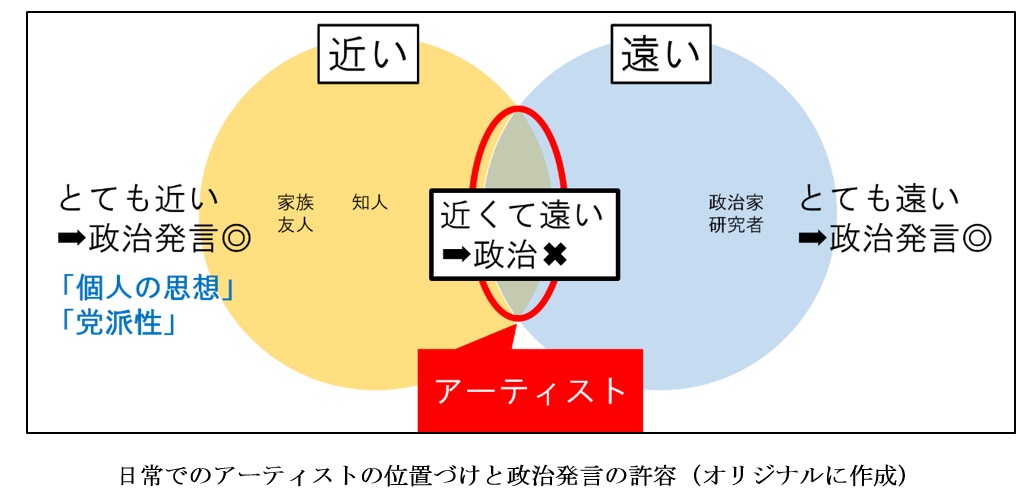In this article, we introduce the research of “Nationalistic TV Programs in Japan” serially. Part.1 is uploaded in here , and Part.2 is in here.
7. National Identity and Self-Orientalism
In previous sections, we described about TV stations and Japanese and argued that nationalistic TV program gives them good points of Japan and the evidence of the pride of Japanese. However, we can be praised by not only TV programs, but friends and colleagues. Why does TV programs play the role to encourage Japanese? We focus on the relationship of Japanese with foreigners.
Figure 7-1 shows that there are only 30% of Japanese who have non-native friends. From the result, a lot of Japanese does not have opportunity to talk with non-natives. From the small number of people who has non-native friends, Japanese people might use TV for the tool of knowing non-native opinions.
Actually, a lot of opinions have positive image for nationalistic TV programs. In this research, we investigate the impressions from audience of the TV program of “You ha Nani Shi ni Nippon e? (Why did you visit Japan?)” (YOUは何しに日本へ?) in the website “Y!TV” produced by Yahoo.
The example of impressions for the nationalistic TV program
- I enjoy the program. Even I’m Japanese, I can find out the figure of “JAPAN” again in different ways in this program.
- The foreigners who comes to Japan are pretty interested in Japan. However, every people have different interests. I learned various findings from the difference.
- The TV program makes Japanese to rearise good point of Japan from non-natives viewpoints. It would give Japanese some pride of Japan.”
From these impressions, TV program would help to realize good point again and make people to find and know new knowledge of Japan.
Moreover, Yonekura studies same contents: “You ha Nani Shi ni Nippon e? (Why did you visit Japan?)”. Yonekura compares the nationality of people between who visit Japan and appear on the TV program. Table 7-2 shows the comparison.
The survey by Immigration Bureau shows Asian come to Japan over 60%, but the TV program used Asian only 20%. TV programs does not reflect the real situation of foreigner in Japan. The number of western who appears on TV contents are controlled to appear more often than Asian (Yonekura.R, 2015). Why does nationalistic TV program need such control of appearance? The concept of self-orientalism (Iwabuchi 2001, 2007) is favorable to consider the question.
In this context, some parts of Asian culture come same origin with Japan and Asian have a lot of similar culture. Therefore, it is not easy to make clear difference if Asian appears in nationalistic TV programs. On the other hand, western culture has the totally different origin from Japan and western people are suitable to appear in the programs.
Iwabuchi argues that the image of Japan was made by Western Orient, but actually, Japan use that image for representing themselves. It is called as self-orientalism (Iwabuchi 2001). With the concept of self-orientalism, we can understand that the difference between western and Asian is based on self-orientalism. In nationalistic TV program, we sometimes see traditional cultures in Japan. However, it is out of date in present Japan. Traditional culture is the tool of represent self-orientalism: it fits to the oriental image proposed by western countries.
8. Conclusion
In this research, we consider that the increasing of nationalistic TV program are caused by characteristic of Japanese media and national identity.
From the aspect of media, nationalistic TV programs were suitable tool to cutting costs of creating TV contents. It is one of good solution for the situation of economic depression from 2008. Especially, TV Tokyo plays the innovative role and other TV station follows it.
Moreover, nationalistic TV programs were excellent tools for the Japanese to become superior to foreigners because it is one of the best way to tell Japanese wonderful points of Japan concretely. To satisfy the desire, the TV program make westerns to appear in the contents. It is a kind of self-orientalism in contemporary Japan.
References
Mamoru Ito. (2002). Mediabunka no Kenrykusayou(The Power Action of Media Culture). Serika-shobo.
Koichi Iwabuchi. (2001). Transnational Japan. Iwanami-shoten.
Koichi Iwabuchi (2007). Bunka no Tiwaryoku –Brand Nationalism to Soft Power wo Koete-(Dialogue Ability of Culture -Beyond Brand Nationalism and Soft Power-). Nihon Keizai shinbun-shuppansha.
Tetsuhiko Simazaki., Masayuki Ikeda.& Ritsu Yonekura. (2009). Housouron(Broadcasting Teory). Gakubun-sha.
Akira Nakamura. (2016). National Identity to Jikoai – Aikokusin to Nationalism no Sai ni tyumoku shite(National Identity and Self-love -Focusing on the difference between patriotism and nationalism-). Kokufudai Keizai kenkyu 26, p.63-80
Tadanori Hayakawa. (2015). Nihon sugoi no Distopia (Distopia of Japan Great: Genealogy of Self-praised during Wartime). Seikyusha
Original Article written by Kanako Koga
Translated by Naoko Imori, Kanako Koga, Kazutaka Oku, Chiaki Sato and Shin Tanaka

